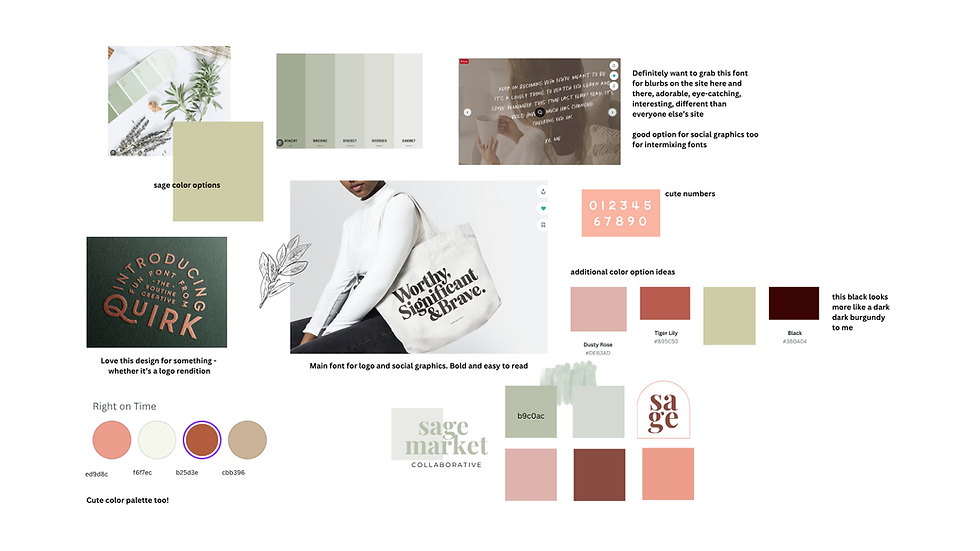Branding 101 for Small Businesses and Entrepreneurs
- sagemarketcollab
- Jul 24
- 4 min read
If you’re just starting out or looking to boost your small business, you’ve probably heard that branding is super important. But what does that mean?
Let’s break it down together and discover how to create a brand that not only stands out but also connects with your customers on a personal level.
What is Branding Anyway?
Think of branding as the personality of your business. It’s not just your logo or the name on your storefront; it’s everything about how you present yourself to the world. From your business name and logo to your colors and messaging, branding encompasses your entire business identity and how you communicate your value to your audience.
Some examples of well-known strong brands include:
Apple - Known for its innovative technology and sleek design, Apple's brand identity emphasizes simplicity and creativity.
Nike - With its powerful "Just Do It" slogan, Nike represents athleticism and perseverance.
Coca-Cola - This brand is synonymous with happiness and refreshment. Coca-Cola's iconic red and white branding is instantly recognizable.
Amazon - As the largest online retailer, Amazon's brand is built around convenience, fast delivery, and a vast selection of products.
Let's create a strong brand for you!
Create a Unique Brand Identity

Your brand identity is like your business’s outfit—it should be eye-catching and represent who you are.
Here are some key components to consider:
Logo: Design a logo that’s easy to remember and reflects your business’s personality.
Color Palette: Colors can evoke feelings, so choose a palette that captures the essence of your brand.
Typography: The fonts you choose should match your brand's vibe and be consistent throughout your materials.
When it comes to establishing a strong brand identity, one of our favorite, easy-to-use tools for DIYers is Canva. This design platform offers a variety of templates specifically for logo design, making it accessible for entrepreneurs at all levels. With its user-friendly interface, anyone can create a professional-looking logo without the need for extensive design skills. Disclaimer: Canva does not provide all file types you may need. We encourage you to learn about file types. Seeking a professional graphic designer who understands which file types you will need for your logo may be a wise investment that we do not want to dismiss. They would also be highly instructed in color theory and have the ability to provide a one-on-one custom experience. Canva is not a one-size-fits-all, and we recognize and value professionals in the industry.
Find Your Brand Voice
Now it’s time to think about how you’ll communicate. Your brand voice is your tone and style of writing. Are you friendly and casual or more professional and serious? Whatever you choose, make sure it aligns with your brand identity and resonates with your audience.
Brand voice can be applied across various platforms and channels to ensure consistent communication.
Here are some key areas where brand voice is essential:
Website - The tone and language used in website content, including product descriptions, blog posts, and the About Us page, should reflect the brand voice.
Social Media - Posts, captions, and interactions on platforms should consistently convey the brand's personality and tone.
Email Marketing - Newsletters and promotional emails should maintain a consistent voice that reflects the brand's identity and engages the audience.
Advertising - All advertising materials, including print ads, online campaigns, and video commercials, should utilize the brand voice to attract and engage the target audience.
Applying a consistent brand voice across all these channels helps create a cohesive identity, builds trust with the audience, and enhances overall brand recognition.
Tell Your Brand Story
Every brand has a story, and yours can be a powerful way to connect with customers. Share your journey—what inspired you to start this business, the challenges you’ve faced, and your successes along the way. A good story can turn potential customers into loyal fans!
A brand story can be shared and told through various platforms, including:
Website - A dedicated “About Us” page or a storytelling section can provide visitors with insights into the brand's history, mission, and values.
Social Media - Platforms like Instagram, Facebook, Twitter, and LinkedIn allow brands to share their stories in engaging formats, including posts, stories, and videos.
Email Marketing - Newsletters can include segments that tell parts of the brand story, update audiences on milestones, and share personal anecdotes.
Events and Workshops - Engaging with customers directly through events allows brands to communicate their story in a more personal and interactive way.
Packaging - Unique and compelling packaging can tell a brand story through design elements and messaging that reflect the brand's values and mission.
Maintain Consistency - It's a MUST!
Consistency is super important when it comes to branding. Make sure that your logo, colors, voice, and messaging are the same across your website, social media, packaging, and anywhere else customers might interact with your brand. This helps build recognition and trust.
Final Thoughts
Branding is an exciting journey that takes time and creativity. By defining your identity, creating a memorable presence, and genuinely engaging with your audience, you can develop a brand that captures attention and builds lasting loyalty.
Happy branding!
Better together,
Nicky + Ashley







Comments